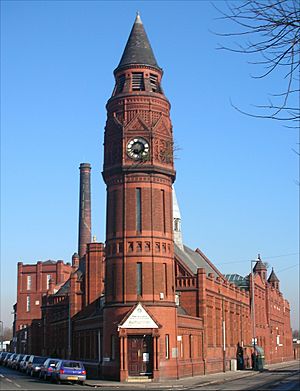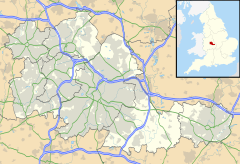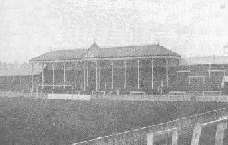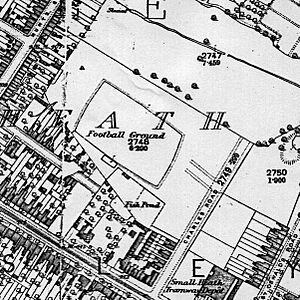Small Heath facts for kids
Quick facts for kids Small Heath |
|
|---|---|
 Green Lane Masjid, formerly Green Lane Public Library and Baths (Martin & Chamberlain 1893–1902) |
|
| Population | 36,898 |
| OS grid reference | SP1085 |
| Metropolitan borough | |
| Shire county | |
| Metropolitan county | |
| Region | |
| Country | England |
| Sovereign state | United Kingdom |
| Post town | BIRMINGHAM |
| Postcode district | B9, B10 |
| Dialling code | 0121 |
| Police | West Midlands |
| Fire | West Midlands |
| Ambulance | West Midlands |
| EU Parliament | West Midlands |
| UK Parliament |
|
Small Heath is a busy area in south-east Birmingham, West Midlands, England. It is located about 2 kilometres (1.2 miles) from the city centre, along the Coventry Road.
Contents
A Look at Small Heath's Past
Small Heath has a long history, with people living and using the land since Roman times. It sits on a small hill. The land here was not great for farming. It was a heathland, which is an open area with low-growing plants. This land was good for animals to graze.
It was likely used as common land where local people could let their animals eat grass. Since it was on the main road between Birmingham and Coventry, it was also used by people moving animals between the two cities.
The Coventry Road was first mentioned in 1226. It started from the Digbeth crossing of the River Rea. In 1745, the Coventry Turnpike was set up. This meant people had to pay a toll to use the road.
How Small Heath Grew
Small Heath was first recorded in 1461. The name referred to a narrow heath between Green Lane and Coventry Road. This is where the baths and library were built later. In 1799, the Warwick and Birmingham Canal (now the Grand Union Canal) opened. This canal helped define the southern edge of the area. In 1852, the Birmingham and Oxford Junction Railway opened, following the same path.
As Birmingham grew, richer people looked for homes outside the crowded city. Small Heath, being green and close to the city, started to develop. Large houses appeared in 1834. Later, many terraced houses were built for working-class families.
The Story of Muntz Street Football Ground
Building homes in Small Heath became easier and cheaper because of the local clay. This clay was dug up and turned into bricks right there. The biggest clay pit was on Cattell Road.
In 1875, members of Holy Trinity Cricket Club formed the Small Heath Alliance Football Club. They wanted to stay fit during winter. After playing in other areas, they moved to the Muntz Street stadium in 1877. They rented the land for £5 a year. The field could hold 10,000 fans. It was next to Muntz Street and Wright Street, with farmland on the other sides.
The stadium also became the home of the Small Heath Athletic Club. They added a wooden stand and raised the seating areas. This made the stadium big enough for about 30,000 people. In 1895, the football club bought the right to use the ground for £275.
The Small Heath Athletic Club (later called Small Heath Harriers) started using the Muntz Street ground in 1891. They were mainly a cross-country and road-racing club. They also did track and field athletics. In the summer, they could train on the football pitch. Birmingham became a city in 1889. The football club changed its name to Birmingham City Football Club in 1943.
Eventually, the ground became too small. Rising rents also meant they needed a new stadium. The club built a new stadium closer to the city centre, called St Andrew's. The last game at Muntz Street was on December 22, 1906. Birmingham beat Bury 3–1. St. Andrew's hosted its first game that same month. Within months, Muntz Street stadium was taken down. Houses were built on the land, creating Swanage Road.
Small Heath During World War II
By the start of World War II, the BSA Guns Ltd factory in Small Heath was the only one making rifles in the UK. Other factories would not start making them until 1941. BSA Guns Ltd also made .303 Browning machine guns for the Air Ministry. They made 600 guns per week in March 1939. This production grew to over 16,000 per month by March 1942. The army also chose the BSA M20 motorcycle. When the war began, the government took all 690 motorcycles BSA had in stock. They also ordered 8,000 more.
The government passed laws to control food, travel, and supplies. They also allowed people to be made to work for the war effort. When France fell to Nazi forces, British soldiers had to leave their equipment behind in Dunkirk. This meant Britain had very few weapons.
The Home Guard was formed to defend Britain. This created a huge need for more weapons. BSA, being the only rifle maker, had to work extra hard. Workers volunteered to work seven days a week. Motorcycle production also increased from 500 to 1,000 machines per week. This meant a new motorcycle was finished every 5 minutes.
The BSA factory in Small Heath was bombed by German planes on August 26, 1940. A bomb hit the main barrel mill, which was the only one making rifle barrels in the country. This destroyed 750 machines. Two more air raids happened on November 19 and 22, 1940. The raid on November 19 caused the most damage. It destroyed workshops and 1,600 machines. Sadly, 53 employees and over 50 local people died. Another 89 people were hurt. Rifle production stopped for three months.
Two BSA electricians, Alf Stevens and Alf Goodwin, bravely helped rescue their co-workers. Alf Stevens received the George Medal for his courage. Alf Goodwin received the British Empire Medal. After the raids, the government and BSA started spreading out production to other factories across Britain.
Where is Small Heath?
Businesses and Shops
Small Heath has two large supermarkets, Asda and Morrisons. There is also the Ackers Trust, which is an outdoor adventure centre. A business park in the area is home to companies like Virgin Media and Delcam.
Until 1973, Small Heath was home to the huge Birmingham Small Arms (BSA) factory. This factory made many things, including bicycles, motorcycles, guns, and even cars like taxi cabs. It was a very important part of the local economy. The factory closed down when the British motorcycle industry struggled. Now, a business park is on the site, but some original buildings are still used for making things.
On Coventry Road, you can find many Middle Eastern and South Asian restaurants. They serve traditional dishes from places like Lebanon, Syria, Yemen, and Pakistan. There are also Arabian cafes and supermarkets.
Homes in Small Heath
Many terraced houses were built in Small Heath in the late 1800s. Over the next few decades, many Irish immigrants came to live in these homes. After World War II, more immigrants arrived, mostly from the Indian sub-continent. People from the West Indies also settled here. However, Pakistani immigrants, especially from Azad Kashmir, were the largest group to move to Small Heath. House prices in the area have been increasing steadily.
People Living in Small Heath
Small Heath has a population of about 36,898 people. Most residents are of South Asian background, mainly Pakistani (51%). About 22% of the population is White British. There are also many East African residents from Somalia and Eritrea. Most people in Small Heath are Muslim. There are many mosques in the area. The Ghamkol Shariff Masjid is the largest mosque in Small Heath and one of the biggest in the UK.
Parks and Sports
Small Heath has several parks and green spaces. The largest is Small Heath Park, which used to be called Victoria Park. This park sometimes hosts festivals. An episode of Charlie's Garden Army featured a special garden built in Small Heath Park. Small Heath is also home to Birmingham City Football Club's St. Andrew's stadium.
Getting Around Small Heath
The Coventry Road through Small Heath used to be part of the main A45 route from Birmingham to Coventry. In 1985, a new dual carriageway was built to bypass it.
Small Heath has its own train station, Small Heath railway station, on the North Warwickshire Line. The Grand Union Canal also runs through the area. Local transport is very good, with the train station and many bus routes connecting to other parts of the city. The 60 bus goes from Birmingham city centre along Coventry Road towards Cranes Park. The 8C Inner Circle bus also travels through the area. The 27 bus passes the Birmingham City stadium before heading towards Bordesley Green.
In the past, horse-drawn buses ran along Coventry Road. They connected Small Heath to the city centre and other nearby areas. In 1882, a tramline was approved for Coventry Road to Small Heath Park. Four years later, steam trams started running. In the early 1900s, this line was changed for electric trams.
Famous People from Small Heath
- Matthew Edwards, a singer and songwriter.
- Jaykae, a rapper who grew up in Small Heath.
- Peaky Blinders, a famous gang that started in Small Heath.
- Thomas Gilbert, a leader of the Peaky Blinders.
- David Harewood OBE, a British actor and presenter.
- Rowland Emett OBE, a famous British cartoonist.
- Ken Barnes, an English footballer who played for Wrexham and Manchester City. He won the FA Cup with Manchester City.
- George Allen, an English footballer who played over 250 games. He played for Coventry City and Birmingham City.
- Wilfred Emmanuel-Jones, a businessman and farmer.
- Shabana Mahmood, the Labour MP for Birmingham Ladywood. She was born and grew up in Small Heath.
- Shafique Shah, a former Lord Mayor of Birmingham.
- Gerry Summers, a football player for West Bromwich Albion, Sheffield United, Hull City, and Walsall.
- John Carter, an English singer, songwriter, and record producer.
- Wasim Khan MBE, a former British cricketer and general manager of the ICC.
Small Heath in Pop Culture
- The BBC1 series Peaky Blinders shows Small Heath as the home of the Shelby family and their gang.
- The BBC Three series Man Like Mobeen is also set in Small Heath.
|





